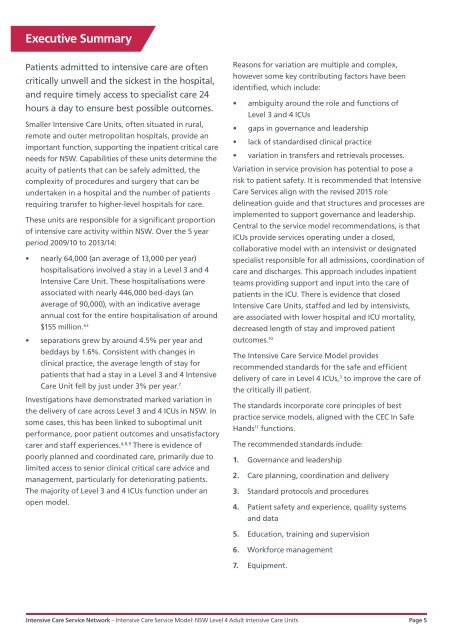Intensive Care Service Model NSW Level 4 Adult Intensive Care Units
1Olm7HQ
1Olm7HQ
Create successful ePaper yourself
Turn your PDF publications into a flip-book with our unique Google optimized e-Paper software.
Executive Summary<br />
Patients admitted to intensive care are often<br />
critically unwell and the sickest in the hospital,<br />
and require timely access to specialist care 24<br />
hours a day to ensure best possible outcomes.<br />
Smaller <strong>Intensive</strong> <strong>Care</strong> <strong>Units</strong>, often situated in rural,<br />
remote and outer metropolitan hospitals, provide an<br />
important function, supporting the inpatient critical care<br />
needs for <strong>NSW</strong>. Capabilities of these units determine the<br />
acuity of patients that can be safely admitted, the<br />
complexity of procedures and surgery that can be<br />
undertaken in a hospital and the number of patients<br />
requiring transfer to higher-level hospitals for care.<br />
These units are responsible for a significant proportion<br />
of intensive care activity within <strong>NSW</strong>. Over the 5 year<br />
period 2009/10 to 2013/14:<br />
• nearly 64,000 (an average of 13,000 per year)<br />
hospitalisations involved a stay in a <strong>Level</strong> 3 and 4<br />
<strong>Intensive</strong> <strong>Care</strong> Unit. These hospitalisations were<br />
associated with nearly 446,000 bed-days (an<br />
average of 90,000), with an indicative average<br />
annual cost for the entire hospitalisation of around<br />
$155 million. 63<br />
• separations grew by around 4.5% per year and<br />
beddays by 1.6%. Consistent with changes in<br />
clinical practice, the average length of stay for<br />
patients that had a stay in a <strong>Level</strong> 3 and 4 <strong>Intensive</strong><br />
<strong>Care</strong> Unit fell by just under 3% per year. 7<br />
Investigations have demonstrated marked variation in<br />
the delivery of care across <strong>Level</strong> 3 and 4 ICUs in <strong>NSW</strong>. In<br />
some cases, this has been linked to suboptimal unit<br />
performance, poor patient outcomes and unsatisfactory<br />
carer and staff experiences. 4,8,9 There is evidence of<br />
poorly planned and coordinated care, primarily due to<br />
limited access to senior clinical critical care advice and<br />
management, particularly for deteriorating patients.<br />
The majority of <strong>Level</strong> 3 and 4 ICUs function under an<br />
open model.<br />
Reasons for variation are multiple and complex,<br />
however some key contributing factors have been<br />
identified, which include:<br />
• ambiguity around the role and functions of<br />
<strong>Level</strong> 3 and 4 ICUs<br />
• gaps in governance and leadership<br />
• lack of standardised clinical practice<br />
• variation in transfers and retrievals processes.<br />
Variation in service provision has potential to pose a<br />
risk to patient safety. It is recommended that <strong>Intensive</strong><br />
<strong>Care</strong> <strong>Service</strong>s align with the revised 2015 role<br />
delineation guide and that structures and processes are<br />
implemented to support governance and leadership.<br />
Central to the service model recommendations, is that<br />
ICUs provide services operating under a closed,<br />
collaborative model with an intensivist or designated<br />
specialist responsible for all admissions, coordination of<br />
care and discharges. This approach includes inpatient<br />
teams providing support and input into the care of<br />
patients in the ICU. There is evidence that closed<br />
<strong>Intensive</strong> <strong>Care</strong> <strong>Units</strong>, staffed and led by intensivists,<br />
are associated with lower hospital and ICU mortality,<br />
decreased length of stay and improved patient<br />
outcomes. 10<br />
The <strong>Intensive</strong> <strong>Care</strong> <strong>Service</strong> <strong>Model</strong> provides<br />
recommended standards for the safe and efficient<br />
delivery of care in <strong>Level</strong> 4 ICUs, 3 to improve the care of<br />
the critically ill patient.<br />
The standards incorporate core principles of best<br />
practice service models, aligned with the CEC In Safe<br />
Hands 11 functions.<br />
The recommended standards include:<br />
1. Governance and leadership<br />
2. <strong>Care</strong> planning, coordination and delivery<br />
3. Standard protocols and procedures<br />
4. Patient safety and experience, quality systems<br />
and data<br />
5. Education, training and supervision<br />
6. Workforce management<br />
7. Equipment.<br />
<strong>Intensive</strong> <strong>Care</strong> <strong>Service</strong> Network – <strong>Intensive</strong> <strong>Care</strong> <strong>Service</strong> <strong>Model</strong>: <strong>NSW</strong> <strong>Level</strong> 4 <strong>Adult</strong> <strong>Intensive</strong> <strong>Care</strong> <strong>Units</strong> Page 5


